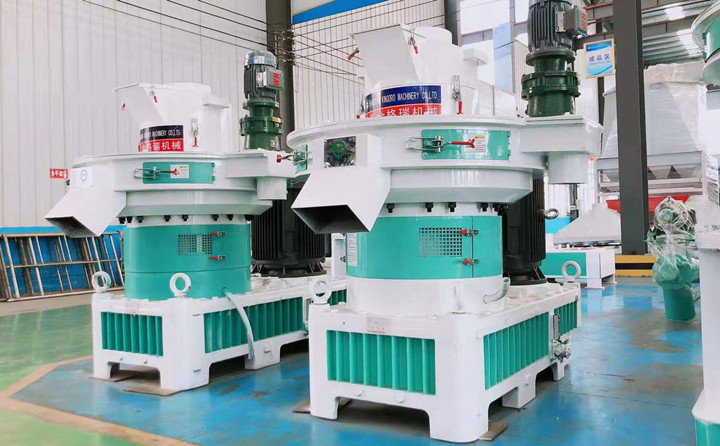The ring die straw pellet machine is the key equipment of the biomass fuel pellet production process, and the ring die is the core part of the ring die straw pellet machine, and it is also one of the most easily worn parts of the ring die straw pellet machine. Study the reasons for ring die failure, improve the use conditions of ring die, improve product quality and output, reduce energy consumption (granulation energy consumption accounts for 30% to 35% of the total energy consumption of the entire workshop), and reduce production costs (ring die loss one The cost of the project accounts for more than 25% to 30% of the decoration cost of the entire production workshop) and has a great impact.
1. Working principle of ring die pellet machine
The ring die is driven to rotate by the motor through the reducer. The pressing roller installed in the ring die does not revolve, but rotates on its own due to friction with the rotating ring die (by compacting the material). The quenched and tempered materials entering the pressing chamber are evenly distributed between the pressing rollers by the spreader, clamped and squeezed by the pressing rollers, and continuously extruded through the die hole of the ring die to form columnar particles and follow the ring die. The ring is rotated, and the granular biomass fuel particles of a certain length are cut by a cutter fixedly installed outside the ring die. The line speed of the ring die and the nip roll is the same at any point of contact, and all of its pressure is used for pelletizing. In the normal working process of the ring die, there is always friction between the ring die and the material. As the amount of material produced increases, the ring die gradually wears out and eventually fails. This paper intends to analyze the failure causes of the ring die, so as to make suggestions on the manufacturing and use conditions of the ring die.
2. Analysis of failure causes of ring die
From the perspective of the actual failure phenomenon of the ring die, it can be divided into three categories. The first type: After the ring die has been working for a period of time, the inner wall of each small hole of the material is worn out, the diameter of the hole increases, and the particle diameter of the produced granular biomass fuel exceeds the specified value and fails; the second type: After the inner wall of the ring die is worn, the inner surface The unevenness is serious, which hinders the flow of biomass fuel particles, and the discharge volume decreases and stops using; the third type: after the inner wall of the ring die is worn, the inner diameter increases and the wall thickness decreases, and the inner wall of the discharge hole also wears with the wear. , so that the wall thickness between the discharge holes is continuously reduced, so the structural strength decreases. Before the diameter of the discharge holes increases to the allowable specified value (that is, before the first type of failure phenomenon occurs), in the most dangerous Cracks first appeared on the cross-section and continued to expand until the cracks extended to a larger range and the ring die failed. The substantial causes of the above three failure phenomena can be summed up as abrasive wear first, followed by fatigue failure.
2-1 Abrasive wear
There are many reasons for wear, which are divided into normal wear and abnormal wear. The main reasons for normal wear are the formula of the material, the crushing particle size, and the quenching and tempering quality of the powder. Under normal wear conditions, the ring die will be uniformly worn in the axial direction, resulting in a larger die hole and a thinner wall thickness. The main reasons for abnormal wear are: the pressure roller is adjusted too tightly, and the gap between the roller and the ring die is small, and they wear each other; the angle of the spreader is not good, resulting in uneven distribution of materials and partial wear; the metal falls into the die and wears. In this case, the ring die is often worn irregularly, mostly in the shape of a waist drum.
2-1-1
Raw material particle size Raw material pulverization fineness should be moderate and uniform, because raw material pulverization fineness determines the surface area composed of biomass fuel particles. If the particle size of the raw material is too coarse, the wear of the die will be increased, the productivity will be decreased, and the energy consumption will be increased. It is generally required that the raw materials should pass through the 8-mesh sieve surface after being crushed, and the content on the 25-mesh sieve should not exceed 35%. For materials with high crude fiber content, adding a certain amount of grease can reduce the friction between the material and the ring die during the granulation process, which is beneficial for the material to pass through the ring die, and the pellets have a smoother appearance after forming. Ring die straw pellet machine
2-1-2
Contamination of raw materials: Too much sand and iron impurities in the material will speed up the wear of the die. Therefore, the cleaning of raw materials is very important. At present, most biomass fuel pellet plants pay more attention to the removal of iron impurities in the raw materials, because iron substances will cause strong damage to the press mold, press roller and even equipment. However, no attention is paid to the removal of sand and gravel impurities. This should arouse the attention of users of ring die straw pellet machine
Post time: Jun-27-2022










